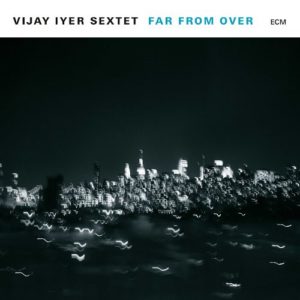Vijay Iyer Sextet
Far From Over
ECM 2581
Steve Lehman, Alto Saxophone; Graham Haynes, Cornet, Flugelhorn, Electronics; Stephen Crump, Double Bass; Tyshawn Sorey, Drums; Vijay Iyer, Piano, Electric Piano; Mark Shim, Tenor Saxophone
After successful outings for ECM in groupings ranging from duets (with Wadada Leo Smith) to a string quartet plus piano/electronics quintet, Vijay Iyer returns for his fifth recording for the label with a jazz sextet date, Far From Over. This time out, he employs an old school resource: the electric piano. This plus concert grand are prominently featured, but by no means dominate the proceedings. Iyer affords his collaborators considerable latitude. Given the level of artists with whom he is partnering, this is a wise choice indeed.
Graham Haynes, in particular, is new to me and makes a forceful impression. His clarion parts on unison tutti, derby calls on the title track, and crackling electronics on “End of the Tunnel” impress both melodically and texturally. Altoist Steven Lehman supplies a formidably funky solo on album opener “Poles.” Recent MacArthur “Genius Grant” recipient Tyshawn Sorey gives a forceful master class in polyrhythmic drumming on the title track (and elsewhere). He and bassist Stephen Crump make an admirable rhythm section duo, in frequent dialogue yet also able to sustain simultaneous alternative pathways. The sextet may be the only jazz ensemble with two MacArthur grant holders – Iyer was previously awarded one as well. “Down to the Wire” features energetic soloing both from the pianist and tenor saxophonist Mark Shim, whose round tone and extensive range are put to good use.
The group as a whole tackles unison sections with enviably well-coordinated yet energetic performances. Far From Over is one of the most impressive jazz outings this year, from the standpoint of solos, collective offerings, and engaging compositions. Recommended.




